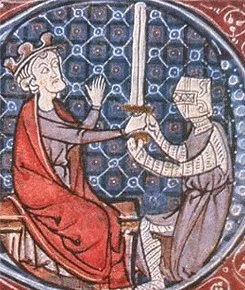Kings, Lords, and Lairds
To ease us into discussing the Middle Ages, I thought we could start with examining the titles found in Scotland during this period. In this post, I will focus on titles introduced with feudalism by David I, which had spread throughout the lowlands and borders of Scotland by the time of Robert I’s rule. I will cover the Highland Clan system of titles in my next post. Both sides were something I had to come to grips with when I was character building as many of them span different social classes and areas of Scotland. Please note, dear Reader, I am not a history expert and while all care has been taken, there may be inaccuracies.
At the top of the system was the monarch – the high ruler of the Scots (the people, not the land). Although it could be debated as to how much control the monarch had! While Alexander II and Alexander III officially unified Scotland, Mann, and the Western Isles (separately ruled by Norway), these areas along with the Highlands, were still heavily under the power of the clans that lived there and would be for centuries.
The title of Duke was not introduced in Scotland until 1398. It was created for the son of Robert III and later went on to be granted as a subsidiary title to the heirs of the throne of Scotland. It is still an active title and is carried by Prince Charles. Marquess did not appear in Scottish peerage until James VI introduced it in 1599. I admit that have done little research on them as my current project is at an earlier point in history.
This leaves the rank of Earl/Countess as the highest peerage during Robert I’s reign and derives its origins from the Norse title of Jarl. It is a title that once granted is passed down primarily through the male line. If their heir was a woman, then her husband would hold it in her stead; in the case of multiple heiresses, then the ultimate decision was in the hands of the king. This meant that Scottish Earldoms lasted for centuries and led to very little earlships being created. For writers like me, it means we must bend the history a bit if we want purely fictional characters to have an earlship.
Viscount is another title that does not appear in Scotland until a later date in 1620.
Barons formed most Scotland’s peers. The barony has a seat and whoever owned the land it sat on became the baron. While it was predominantly hereditary, it was also a title that could be bought and sold with the land. Those who were not noble born and received the titles were known as minor barons and sat below the noble-born baron.
Next came the knight. Normally the noble-born son waiting to inherit or one who was unable to inherit but wished to secure some prestige. Some commoners could be knighted for outstanding service but as knights had high maintenance costs, it could be difficult for those without wealth. They were the medieval equivalent of modern day commissioned officers, trained in warfare from a young age.
I could leave it there, dear reader, but to understand Scotland’s ranks, we must also understand what a Laird is and is not. It is not a peerage title, though a peer can use the term, and applies to a person holding an estate of land – note the size. I’m afraid those square foot plots that ‘guarantees a title’ are just a gimmick. Trying to research the term is not easy thanks to those sites. From the late fifteenth century, the laird is described as a person who only has one overlord - the king. It’s not surprising then, that most lairdships would be found in the lowlands and borders. Although I could find nothing earlier, I’ve used this definition as inspiration in the story I am currently writing.
So there we have it; the feudal side of medieval Scotland. I hope I have not caused any headaches beside the big one I gave myself when I was researching this. Just to reiterate, I’ll be looking at the highland clan system next week. The similarities are quite striking!
Until next time…
David I (Unknown author, Public domain, via Wikimedia Commons)
